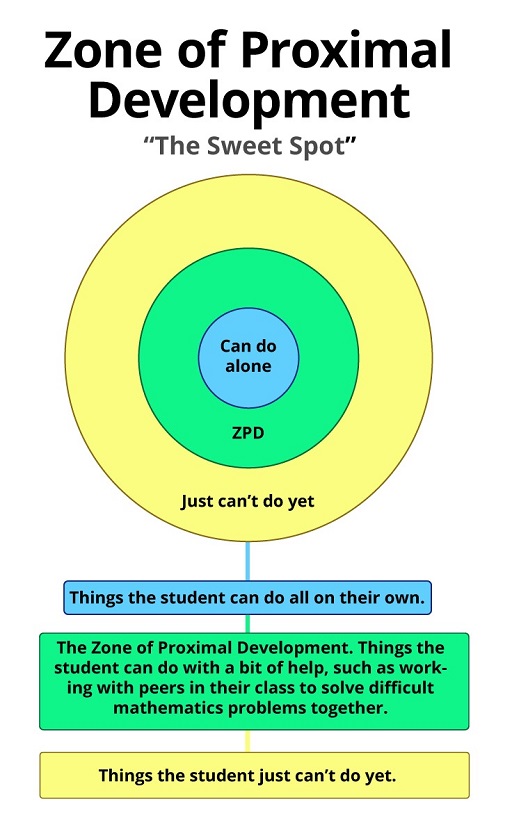4.2 Zone of proximal development
Students who are struggling together to learn something have no expert blind spots. They can thus often be more helpful to one another than the teacher can. A second theory about learning, one developed a century ago by Russian educational thinker L.S. Vygotsky, helps explain why this is so.
Vygotsky argued that we should identify two levels of ability in learners: their current state of ability, and the abilities that they might achieve with the help of experienced peers or guides. In other words, imagine ten mathematics problems of increasing difficulty. Working on his or her own, a student might be able to solve all the way through problem six. However, if that student were to join together with two peers, the three of them might be able to help each other get through problem eight.
The difference between these two levels of achievement - what the student could accomplish on his or her own and what he or she could accomplish with the help of peers - was described by Vygotsky as that student’s zone of proximal development. In other words, that zone represents the next stage of learning that the student can achieve when he or she works collaboratively with others (Vygotsky, 1978).
The following activity illustrates how the E4J Modules utilise social learning methods to support students’ engagement with ethical concepts.
Activity 4.2 Case study – Baby Theresa 
This activity is taken from an exercise in E4J Ethics Module 1.
Students are presented with the following set of facts (the full details of the case are included in The Elements of Moral Philosophy by Rachels and Rachels, 2012):
Baby Theresa was born in Florida (United States of America) in 1992 with anencephaly, one of the worst genetic disorders. Sometimes referred to as “babies without brains”, infants with this disease are born without important parts of the brain and the top of the skull is also missing.
Most cases are detected during pregnancy and usually aborted. About half of those not aborted are stillborn. In the United States, about 350 babies are born alive each year and usually die within days. Baby Theresa was born alive.
Her parents decided to donate her organs for transplant. Her parents and her physicians agreed that the organs should be removed while she was alive (thus causing her inevitable death to take place sooner), but this was not allowed by Florida law. When she died after nine days the organs had deteriorated too much and could not be used.
The exercise suggests you encourage a discussion amongst your students around the following questions
How do we put a value on human life?
What should one do when there is a conflict between the law and one’s own moral position about an issue?
If you were in a position to make the final decision in this case, what would it be and why?
This case study provides a particularly emotive topic for discussion, which is not uncommon when dealing with issues of ethics. What techniques could you employ to ensure that your students engage positively with this discussion, despite the sensitive nature of the topic?
Answer
The answer to this question will depend upon your own particular teaching context, the size of the class and how well you know the group. When dealing with sensitive topics it can be helpful to depersonalise the issues and encourage students to explore points of view that they wouldn’t normally take.
One way of doing this is to allow students the opportunity to discuss the in small groups of three or four, before widening the discussion to the whole group. You then have the option of asking someone to report the ideas of the whole group which can avoid personalising the responses.
Alternatively, you could ask students, or small groups of students, to assume particular roles, or to argue for particular positions. For example, you could ask different groups to represent the views of parents, physicians and lawmakers. The rest of the group could then play the role of a jury where they are able to put questions to the groups before taking a vote on whether to allow the operation to take place.
4.1 Expert ‘blind spots’

